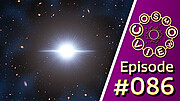Quasar feedback plays a key role in shaping the evolution of the most massive galaxies in the universe. As the supermassive black hole at the centre of a galaxy accretes matter, it powers a quasar — a bright, energetic outburst that can blow powerful winds and emit radiation into the surrounding galaxy. This energy can either heat up or sweep away the gas that would otherwise form new stars, thereby effectively shutting down star formation. This explains why giant galaxies stop growing and become filled with older stars. However, in principle, a quasar is not only able to affect its host galaxy's interstellar medium (its local fuel reservoir), but also the surrounding intergalactic gas. This means that a quasar could have an impact also on the fresh fuel for future star formation in the galaxy, thereby accelerating the galaxy quenching. Despite these ideas have been extensively discussed, the details of this feedback process still need to be fully understood.
Since the 1980s, it has been proposed that the impact of quasar energy on the surrounding gas could be assessed by targeting one of the most important lines of the hydrogen atom: the Lyman-alpha line. In a hydrogen atom, the electron can occupy different energy levels, like steps on a ladder. This specific ultraviolet line is emitted when an electron drops from the second energy level to the first. Since hydrogen is the most abundant element in the universe, this transition is ubiquitous and results in such bright emission that it can be seen at distances of billions of light years, enabling us to study galaxies and their surrounding gas in the early universe. Novel wide-field spectrographs, in particular, have opened a new window on the Lyman-alpha emission surrounding quasars. They allow the detection of emitting gas at distances of several hundred thousand light years from their host galaxies with short exposure times (about one hour; see, for example, Highlights from November 2019, May 2022 and January 2025).
Thanks to this new instrumentation — specifically the integral-field spectrograph MUSE on the Very Large Telescope — an international team led by MPA scientists has surveyed the largest sample of quasars to date in order to study their surrounding Lyman-alpha emission. The observations revealed intricate structures enveloping these quasars during cosmic noon, an epoch corresponding to approximately 11.5 billion years ago (examples are shown in Figure 1). Importantly, the 120 targeted quasars cover two orders of magnitude in luminosity, enabling the team to explore the effects of different energy inputs.
The scientists discovered that the surface brightness of the Lyman-alpha emission — how bright the emission appears per unit angular area — depends on quasar luminosity. Brighter quasars are associated with brighter extended emission (see Figure 2, top panel). Similarly, brighter quasars are associated with more turbulent gas reservoirs within about 30 kpc (approximately 100,000 light years; see Figure 2, bottom panel). Both these trends are evidence of the impact of quasar feedback (radiation and winds) on their surroundings. The team is now quantifying these trends in detail. For example, they have found that the velocity dispersion on inner scales varies as a function of quasar luminosity, following a well-defined power law. These findings could be used to test quasar feedback models and how they couple with the gas. Future work will focus on targeting additional line emissions besides Lyman-alpha in order to further constrain the impact of quasars on the gas on such large scales, as well as the physical properties of the emitting gas (e.g. MPA Highlights July 2025).
Authors:
Jay González Lobos, Jay
PhD student
Tel: 2030
valegl@mpa-garching.mpg.de
Fabrizio Arrigoni Battaia
Scientific Staff
Tel: 2288
arrigoni@mpa-garching.mpg.de
Original publication
Jay González Lobos, Fabrizio Arrigoni Battaia, Aura Obreja, Guinevere Kauffmann, Emanuele Paolo Farina, Tiago Costa
Source







